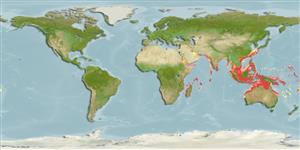Environment: milieu / climate zone / depth range / distribution range
Écologie
marin; saumâtre démersal; amphidrome (Ref. 51243); profondeur 2 - 160 m (Ref. 47581). Tropical; 31°N - 27°S, 36°E - 178°W
Indo-West Pacific: Port Sudan in the Red Sea and the Persian Gulf to Japan, the Arafura Sea (Ref. 9819), and Australia.
Length at first maturity / Taille / Poids / Âge
Maturity: Lm 9.3 range ? - ? cm
Max length : 14.0 cm TL mâle / non sexé; (Ref. 1372); common length : 8.0 cm TL mâle / non sexé; (Ref. 3424); poids max. publié: 19.00 g (Ref. 126702)
Épines dorsales (Total) : 8; Rayons mous dorsaux (Total) : 16 - 17; Épines anales: 3; Rayons mous anaux: 14.
Found over muddy sand bottoms of coastal inshore waters (Ref. 47581). Often enters estuaries (Ref. 4833). Forms schools. Used in Chinese medicine (Ref. 12166).
James, P.S.B.R., 1984. Leiognathidae. In W. Fischer and G. Bianchi (eds.) FAO species identification sheets for fishery purposes. Western Indian Ocean (Fishing Area 51). Vol. 2. FAO, Rome. pag. var. (Ref. 3424)
Statut dans la liste rouge de l'IUCN (Ref. 130435)
Menace pour l'homme
Harmless
Utilisations par l'homme
Pêcheries: intérêt commercial mineur
Outils
Articles particuliers
Télécharger en XML
Sources Internet
Estimates based on models
Preferred temperature (Ref.
123201): 24.5 - 29, mean 28 °C (based on 2086 cells).
Phylogenetic diversity index (Ref.
82804): PD
50 = 0.5625 [Uniqueness, from 0.5 = low to 2.0 = high].
Bayesian length-weight: a=0.01995 (0.01577 - 0.02524), b=2.92 (2.86 - 2.98), in cm total length, based on LWR estimates for this species (Ref.
93245).
Niveau trophique (Ref.
69278): 2.9 ±0.3 se; based on diet studies.
Generation time: 1.1 (0.9 - 1.3) years. Estimated as median ln(3)/K based on 19
growth studies.
Résilience (Ref.
120179): Haut, temps minimum de doublement de population inférieur à 15 mois (K=0.88-2.63; tm=1.2).
Fishing Vulnerability (Ref.
59153): Low vulnerability (14 of 100).
Nutrients (Ref.
124155): Calcium = 471 [235, 1,053] mg/100g; Iron = 1.46 [0.65, 3.11] mg/100g; Protein = 19.5 [17.0, 21.7] %; Omega3 = 0.281 [0.143, 0.559] g/100g; Selenium = 39.1 [12.6, 142.0] μg/100g; VitaminA = 27.5 [7.8, 87.5] μg/100g; Zinc = 2.14 [1.32, 3.33] mg/100g (wet weight); based on
nutrient studies.
